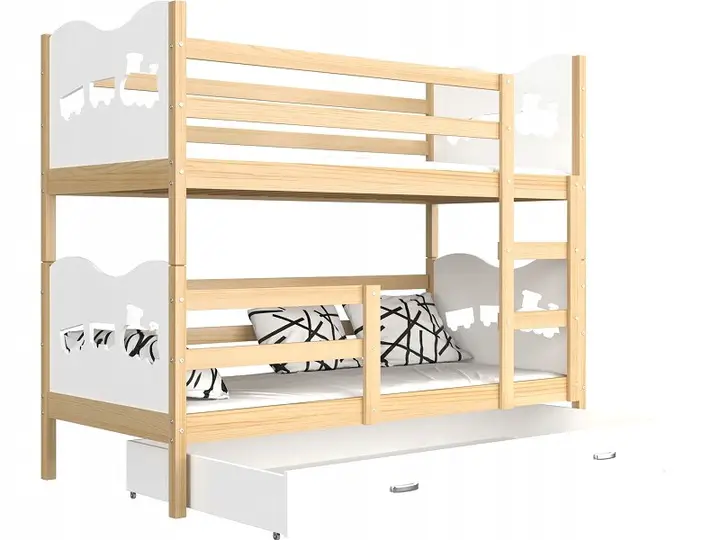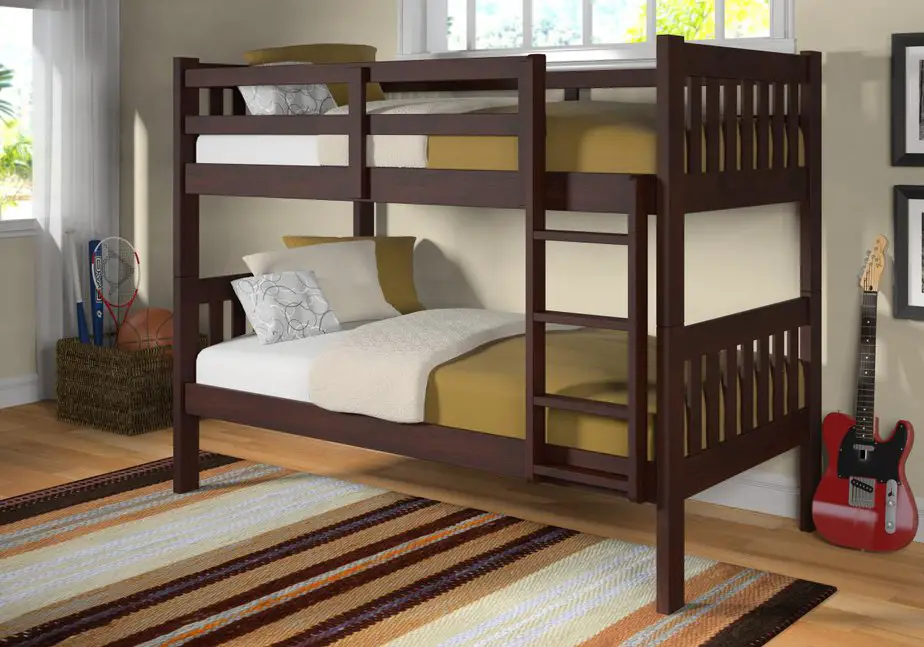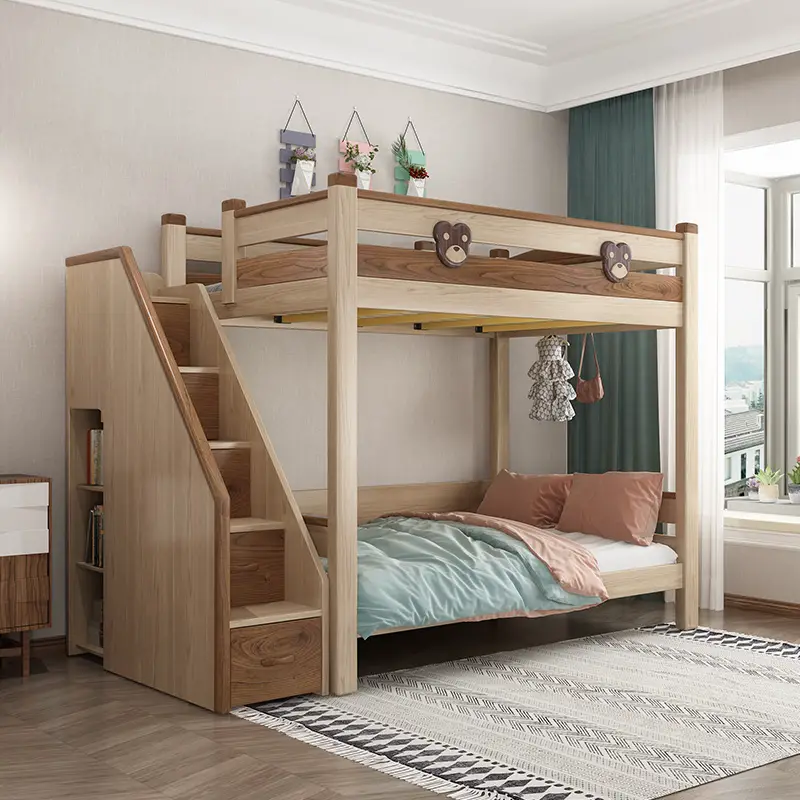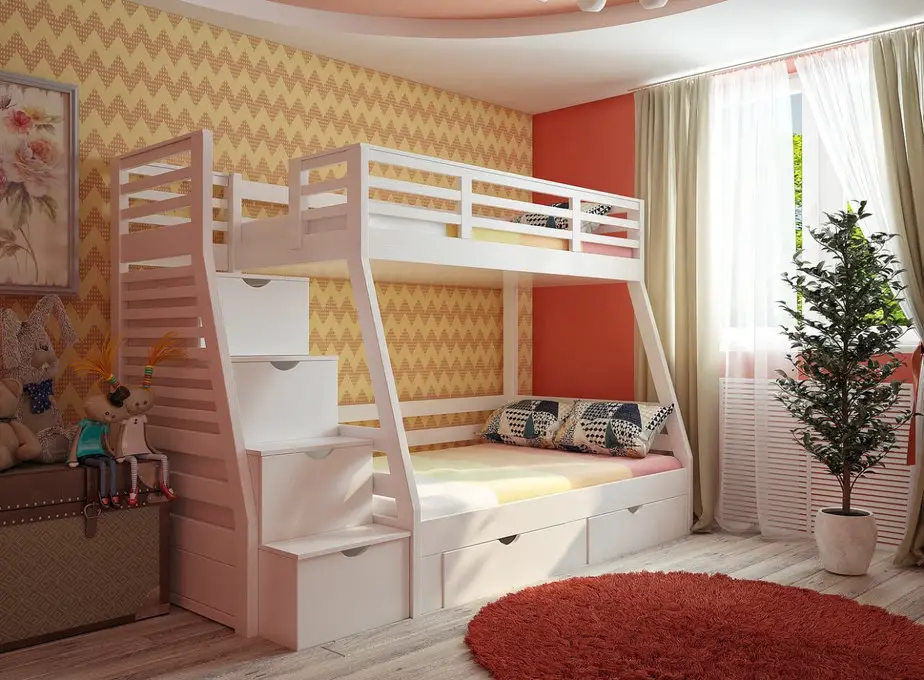Are Bunk Beds Safe For Children if you’re considering purchasing a bunk bed for your children, you may wonder whether bunk beds are safe for children.
Bunk beds can be safe for children if they meet safety standards, are not purchased secondhand, have the proper mattress size, are made of high-quality materials, do not have significant gaps, and do not exceed the weight limit. However, bunk beds can still be hazardous to your child’s health.
Because according to this study conducted by the Research Institute at Nationwide Children’s Hospital at Ohio State University:
More specifically, as cited by another study, more than 63% of the estimated 23,000 children aged 0-9 years treated annually in emergency departments in the US for bunk bed fall-related injuries were under 6 years old.
The majority of the injuries were fractures, lacerations, bruises, and scratches, with 25% resulting from a fall from the top bunk.
Looking further afield, I discovered cases where children died as a result of accidents and incorrect bunk bed assembly by parents.
Including a 4-year-old that passed away due to rolling out of the top bunk and getting his neck trapped between the bed frame and the wall, it was pressed up against – because the relatives had not installed the barrier on the side closest to the wall.
So, if you’re thinking about getting your kids a bunk bed, make sure you read this bunk bed safety guide thoroughly.
(Don’t forget to share it using the buttons at the top or bottom of this page to alert others as well).

Bunk Bed Safety Guide
So, I’m going to walk you through the steps necessary to both identify a safe bunk bed to buy and then have your children use it in a safer manner.
Obviously, the strategies outlined below are not foolproof, and I am not claiming that by following these steps, NO injuries will ever occur, as such certainty is impossible to guarantee.
And if you’re wondering how to build a bunk bed for your kids, I won’t be covering that here because I wouldn’t feel comfortable providing you with such bunk bed plans. If that’s the path you want to take, you should consult with a professional.
However, I consulted with several sources to create this bunk bed safety guide, which should save you some time while also reducing the risks.
There are a total of 14 bunk bed safety tips.
How to Buy a Bunk Bed That’s Safe
Are Bunk Beds Safe For Children here’s what I would personally do when buying a bunk bed for my children.
1: Avoid Buying Second Hand From Individual Sellers

However, I would avoid buying used from a private seller because there’s no telling what kind of care the beds have received, and while they may LOOK safe in the pictures, the wood and joints may not be as stable as they appear on the outside.
If I had to buy used, I’d look for a reputable retailer and question them endlessly about the level of safety checks and precautions taken.
2: Ensure The Bed Meets Safety Standards

In addition to the previous point, you should do your homework to ensure that the bunk bed you’re about to purchase has the proper certification to prove that it has met the required safety standards.
You’ll want to check the product label, look on the manufacturer’s website, or ask the retailer to ensure that the bed meets the most recent ASTM International F1427 standard.
In the UK, the British Safety Standard number BS EN 747:1993 applies.
3: Get The Correct Mattress Size
When buying online, most bunk beds are sold without a mattress.
This means you’ll have to purchase the mattress separately.
And you’ll need to make sure that it not only fits snugly against all four sides of the bed, but that it doesn’t come too high up against the guard rails, or your child may roll out in the middle of the night.
According to this source, the bunk bed rails should be at least 16 cm taller than the mattress.
4: Consider The Materials and Their Qualities
When properly assembled, you’ll want your bed to be sturdy and free of creaks and sways, and the first step is to choose the right construction materials.
Bunk beds are typically made of wood or metal, though I have seen some made of solid plastic as well. To be honest, I would stick with metal and wood and avoid plastic.
The frame for the metal options should be made of steel tubes, metal rods, or wrought iron.
Having said that, wooden bunk beds account for roughly three-quarters of the market, so you’ll most likely be dealing with softwoods like pine, which is perfectly acceptable. If you want to take things a step further, consider hardwoods such as oak, poplar, ash, or cherry for maximum durability.
The following step is to ensure that the pieces are in good condition.

Are Bunk Beds Safe For Children In the most obvious sense, you should inspect the parts to ensure they are free of external damage. Another thing to consider is whether or not the wood is solid all the way through because I’ve seen some cases where laminated timber is used over pressed wood, which isn’t as solid or durable.
Prior to assembly, the parts should be thoroughly checked. If you’re buying bunk beds online, it’s also a good idea to read customer reviews to see if there’s a pattern of complaints about the quality of the materials
5: Check the Maximum Weight Allowances
It’s very important that you find out the maximum weight capacity of the top and bottom bunks.
Because this can vary greatly.
I have seen weights as low as 160 lbs and as high as 400 lbs per bunk.
6: Check the Gaps
To prevent entrapment and strangulation, beds made to the proper safety standards should have narrow gaps between the slats and guardrails.
The distance between the guardrails should not exceed 3.5 inches.
The distance between the slats should not exceed 7.5 cm.
The ladder’s steps must be at least 3 cm wide and 20 cm long.
7: Take Room Dimensions
You should obviously take room measurements to ensure that there is enough floor space for the bunk bed.
But don’t overlook the ceiling clearance.
You’ll want your child to be able to sit up in the top bunk without fear of hitting their head.
How to Use a Bunk Bed Safely
So, now that you’ve found your ideal bunk bed, the next step is to learn how to use it safely.
This begins with assembly and continues through everyday use.
1: Make Sure The Bed is Set Up Properly
Most folks tend to shoulder the responsibility of assembling the bed themselves.
However, I would prefer white glove delivery with the option of having the bed assembled by a professional. I would then double-check their work and test the bed myself to ensure that it does not collapse.
However, if you do decide to build the bed yourself, keep the following points in mind:

- If possible, have someone on hand to help you move the parts/boxes around, speed up the assembly, and lift the top bunk onto the bottom bunk if necessary.
-
Read the instructions carefully to ensure that you are setting up the bed correctly.
Use the right tools – Many bunk beds come with the tools needed for assembly, but if they don’t, make sure you use appropriate tools that won’t damage the bed. - Check, check, and double-check – once the bed is up, make sure that everything is properly held together and that all the joints are secure.
2: Install the Guard Rail on BOTH Sides of the Bed
One of the most common mistakes people make when building a bunk bed for their child is failing to install the guard rail on the side of the bed that faces the wall.
This has proven fatal in some cases, as I previously mentioned.
Don’t put your child in danger of falling down the side and becoming strangled.
3: Position the Bed Safely
Make sure the bed is not too close to any windows and is far enough away from fixtures such as ceiling fans and even doors.
It is recommended that you keep at least two meters away from such items.
Make certain that your child cannot reach for nearby blinds, cords, curtains, or anything else that could cause strangulation, such as robes, belts, or clothing.
4: Do NOT Let a Child Under 6 Use the Top Bunk
According to the study I linked to earlier, the majority of bunk bed injuries occur in children under the age of six.
As a result, current recommendations state that children under the age of six should not use the top bunk at all.
5: Consider Night Time Safety
Before putting your children to bed, make sure you’ve removed any toys or objects from around the bed that could cause a tripping hazard during the night.
It’s also a good idea to use a clip light to quickly illuminate the ladder if your child needs to get up in the dark. This is especially important if they have nightmares and wake up terrified.
6: Explain the Rules
A big part of getting a bunk bed is going to require a fair amount of cooperation from your little ones.
Make sure that you explain to them the following bunk bed safety rules:
- No jumping on the bed. Ever.
- Only one person on the top bunk at all times.
- Keep large toys off the top bunk.
- Only use the ladder/stairs to get in and out of the bed.
- Do not tie anything to the bed or the frame.
7: Don’t Misuse the Bed Yourself
Never be tempted to dry your clothes or hang items from the bed.
If you need to replace any parts, make certain that they are the originals from the manufacturer.
Never modify the bed beyond what is required for safety.
Conclusion: Better Safe Than Sorry
I hope this bunk bed safety guide has clarified some of the points you may not have considered when purchasing and using a bunk bed for your child.
If you have any safety tips of your own, please share them in the comments section below so that others can benefit.
And be sure to use the buttons below to share this post on social media to help others find these bunk bed safety tips.

I joined Appartenville in February 2021 as a content editor. After studying English literature at university, I worked as an e-commerce website editor, content author, and purchasing intern for several independent luxury and lifestyle retail companies. My role at Appartenville combines my love, experience, and passion for the world of design and the desire to create inspiring written content. As for my personal style, I am a big fan of color and drawing, especially I like the pastel color scheme. I also enjoy discovering new trends, brands, and products, whether it’s fashion, interior design, or lifestyle my wish list for buying new things is endless.

Leave a Reply